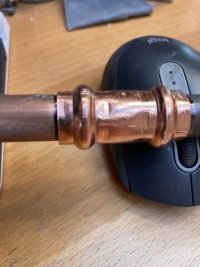Mr Blint
New Member
For almost all of my DIY projects in the past, I used solder and my repairs and my new work have both held up so far for 15 years without leaks. But recently I bought one of the relatively inexpensive bolt-cutter type manual crimping tools for propress-style fittings. I've done a couple dozen crimps in 3/4 and 1/2 copper that appear to be holding up fine. No leaks after a couple of weeks. I also just bought a hydraulic version of one of those crimping tools. It is considerably lighter, and its crimping jaws have a far simpler design that doesn't require the "legs" to be fully splayed like a gymnast doing a split on the balance beam before the crimping head can be opened to enclose the fitting. Its crimping head isn't as massive and there's no risk of getting your finger pinched in gears. I'm expecting the hydraulic one to be far easier to work with, especially when the pipes are overhead between floor joists in the basement.
My question: on the next repair, I need to use a coupling and was wondering if it's important that the crimp on both ends of the coupling line up with each other perfectly and aren't rotated as they are in this photo of my first dry-run test crimp with the new hydraulic tool.
My question: on the next repair, I need to use a coupling and was wondering if it's important that the crimp on both ends of the coupling line up with each other perfectly and aren't rotated as they are in this photo of my first dry-run test crimp with the new hydraulic tool.

